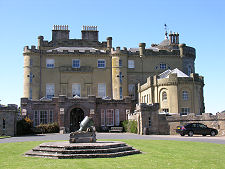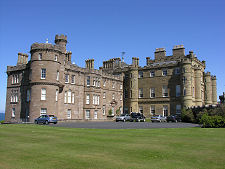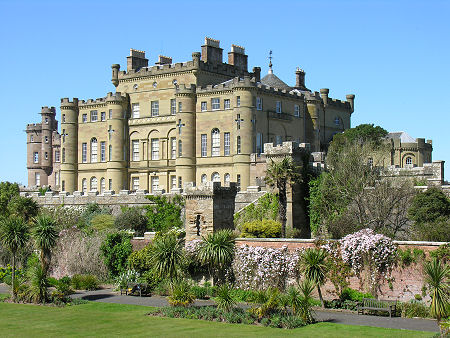 Culzean Castle Seen Over Its Garden |
Culzean Castle stands on the brink of 150ft cliffs that drop sheer into the Firth of Clyde. Regarded by many as one of the finest examples of the architect's art in Scotland, both externally and internally, it is in the care of the National Trust for Scotland. Today the castle forms the focal point of Culzean Country Park, which is the subject of a separate feature to allow this page to be devoted to the castle itself.
Culzean Castle and Country Park together comprise one of the most popular visitor destinations in Scotland, and one of the most rewarding and varied. You can choose to tour the castle and visit the country park, or just visit the country park for a lower entrance fee (see panel, right). In our view it is well worth the additional cost to tour the castle itself: you can have a great day out in the country park without doing so, but will inevitably leave with the sense of having missed something worthwhile.
The origins of Culzean Castle (which is pronounced cull-ane) probably date back to the late 1300s with the building here of a stone tower house. This was referred to in the 1400s as the House of Cove or Coif Castle, both thought to be references to the caves in the cliffs below the castle. By the 1600s it was being referred to as Cullean Castle, and the current spelling came into vogue during the 1700s.
In 1569 the castle and the surrounding lands were given to Sir Thomas Kennedy by his brother, the 4th Earl of Cassilis who preferred to use another family property, Dunure Castle, as his own power-base. Some time in the 1590s, Sir Thomas Kennedy set to work to expand and improve what was by then probably a rather out-of-date and dilapidated castle. The enlarged and improved tower house that emerged went on to form the core of everything that followed.
During the 1600s, the need to display wealth and entertain visitors became seen across Scotland as a more pressing consideration in the design of grand houses than simple defence. During this period gardens and terraces were added at Culzean, but because the family only lived here for part of each year, improvements to the castle itself tended to be fairly sporadic.
In 1742 Culzean Castle was inherited by Sir Thomas Kennedy. In 1762, after a three year legal battle with a rival claimant to the title, Sir Thomas also inherited the Earldom of Cassalis, meaning that for the first time in nearly 200 years, both the earldom and the castle were in the same hands.
Sir Thomas actually began to modernise Culzean Castle in 1750. But it was his son, David Kennedy, the 10th Earl of Cassalis, who was responsible for most of what you see today. As the 18th of a family of 20 children, David Kennedy probably never expected to inherit either the title or the castle: but he inherited both in 1775, and the following year was elected as a Representative Peer in the House of Lords.
The 10th Earl was a bachelor who already had his own house not far from Culzean. His ambition for Culzean was to produce a showpiece that would demonstrate once and for all that the Culzean branch of the Kennedys were worthy holders of the title of Earls of Cassilis. In 1776 he therefore commissioned the noted architect Robert Adam to transform Culzean Castle.
The result was the magnificent main building you see today: though neither David Kennedy or Robert Adam lived to see it finished. Both died in 1792, David Kennedy with debts of £60,000 (£4m in today's money) largely incurred through the costs of rebuilding Culzean Castle and developing its estates.
Before he died, David Kennedy, the 10th Earl of Cassilis took steps to ensure that on his death the title and the (still incomplete) castle and its estates would become the property of a distant cousin, Captain Archibald Kennedy, a wealthy naval captain from New York. His aim seems to have been to ensure that the castle became the property of the one member of the family with the wealth to complete it and maintain it. Archibald Kennedy, the 11th Earl of Cassalis, died in 1794, leaving his recently acquired title and castle, and his fortune, to his son, also called Archibald, who became the 12th Earl of Cassilis.
The 12th Earl took a number of steps to secure the family's fortunes, first by marrying the daughter of a wealthy landowner, and second by gaining for himself a British title (the 1st Marquess of Ailsa) to go alongside his existing Scottish title. When he died in 1846, he left the equivalent in today's money of £9 million.
It was Archibald's grandson, the 3rd Marquess of Ailsa, who had spent his childhood at Culzean, who finished the development of Culzean Castle into what you see today. He commissioned the building of the three storey west wing, largely to provide modern accommodation for his growing family.
The 3rd Marquess was a keen yachtsman who was responsible for starting what became the Ailsa Shipyards in Troon, which continued in operation until only a few years ago. And as a late convert to golf, it was also the 3rd Marquess who convinced the Glasgow & South-Western Railway to develop the golf course and hotel at nearby Turnberry in the years from 1903.
After the 3rd Marquess died in 1938, the family spent much less time at Culzean. In 1945 the widow of the 4th Marquess agreed to hand the castle and grounds over to the National Trust for Scotland, subject to her retaining the use of the west wing for life, and subject to the top floor of the castle being converted into a flat for the use of General Eisenhower as a gesture of gratitude from Scotland, for his part in securing victory during World War II.
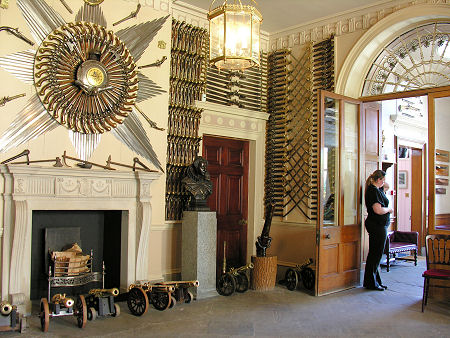 The Armoury |

|
|
|
Visitor InformationView Location on MapSTB 4 Star Visitor Attraction Maybole, KA19 8LE. Tel: 01655 884455. culzean@nts.org.uk. Grid Ref: NS 232 103 www.nts.org.uk NTS: Castle & Park Web Page Opening Hours Admission Accessibility What3Words Location: ///alike.deeds.encodes |
 Library |
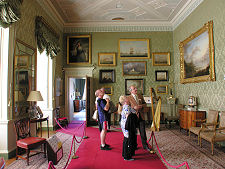 Long Drawing Room |
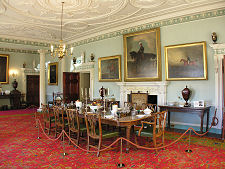 Dining Room |
 Musical Instruments |
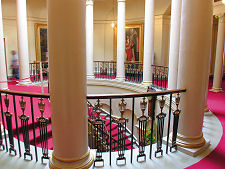 First Floor and Staircase |
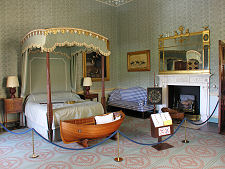 Lady Ailsa's Boudoir |
